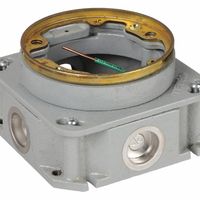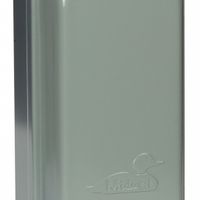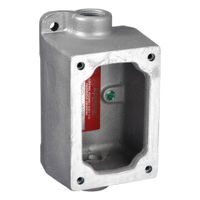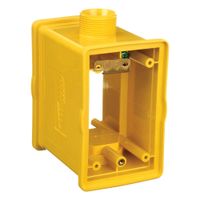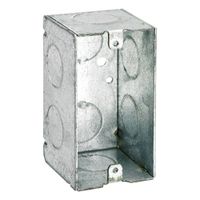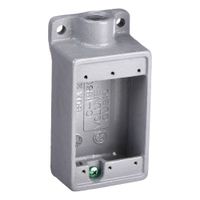Call +(254) 703 030 000 / 751 483 999 / 721 704 777
- Home
- Electrical
- Electrical Boxes Enclosures
- Electrical Boxes Covers
.....Read More
Frequently Asked Questions
What is the difference between a standard electrical box and a weatherproof electrical box?
A standard electrical box and a weatherproof electrical box serve similar functions in housing electrical connections, but they differ primarily in their design and application environments.
A standard electrical box is typically used indoors where it is protected from environmental elements. It is made from materials like plastic or metal and is designed to house electrical connections, switches, and outlets. These boxes are not sealed against moisture or dust, making them unsuitable for outdoor use or in areas exposed to water or high humidity.
In contrast, a weatherproof electrical box is specifically designed for outdoor use or in environments where it may be exposed to moisture, rain, snow, or dust. These boxes are constructed from durable materials such as heavy-duty plastic or metal with a corrosion-resistant finish. They feature gaskets and seals to prevent water ingress, ensuring the safety and integrity of the electrical connections inside. Weatherproof boxes often come with covers or lids that can be securely closed to protect the contents from the elements.
Additionally, weatherproof boxes may have features like knockouts for conduit connections and are often rated by standards such as NEMA (National Electrical Manufacturers Association) or IP (Ingress Protection) to indicate their level of protection against environmental factors.
In summary, the primary difference lies in their intended use and construction: standard electrical boxes are for indoor, protected environments, while weatherproof electrical boxes are designed to withstand outdoor conditions and protect electrical components from moisture and dust.
How do I choose the right size electrical box for my project?
To choose the right size electrical box for your project, consider the following factors:
1. **Box Type**: Determine the type of box needed based on the installation environment (e.g., indoor, outdoor, wet, or dry locations) and the application (e.g., junction, switch, or outlet box).
2. **Volume Requirements**: Calculate the total volume needed to accommodate all wires, devices, and fittings. The National Electrical Code (NEC) provides guidelines for calculating box fill. Each conductor, device, and fitting has a specific volume allowance. Sum these to determine the minimum box volume.
3. **Conductor Count**: Count the number of conductors entering the box. Each conductor requires a specific volume, typically 2.0 cubic inches for 14-gauge wire and 2.25 cubic inches for 12-gauge wire.
4. **Device and Fitting Allowance**: Include volume for devices (e.g., switches, outlets) and fittings (e.g., clamps). Each device typically requires the space of two conductors.
5. **Box Size**: Choose a box that meets or exceeds the calculated volume. Boxes are available in various sizes and shapes, such as single-gang, double-gang, and round or square boxes.
6. **Future Expansion**: Consider future needs. If you anticipate adding more circuits or devices, select a larger box to accommodate potential expansion.
7. **Material and Durability**: Select a box material suitable for the environment, such as plastic for indoor use or metal for areas requiring more durability.
8. **Code Compliance**: Ensure the box complies with local electrical codes and standards, which may have specific requirements for box size and installation.
By considering these factors, you can select an appropriately sized electrical box that ensures safety, functionality, and compliance with electrical standards.
Can electrical boxes be installed outdoors?
Yes, electrical boxes can be installed outdoors, but they must be specifically designed and rated for outdoor use to ensure safety and functionality. Outdoor electrical boxes are typically made from materials like plastic, stainless steel, or aluminum to resist corrosion and withstand various weather conditions. They must be weatherproof or waterproof, often featuring gaskets or seals to prevent moisture ingress.
When installing an outdoor electrical box, it is crucial to adhere to local electrical codes and standards, such as the National Electrical Code (NEC) in the United States. These codes dictate the type of box, installation methods, and protection measures required for outdoor applications. For instance, outdoor boxes should be mounted securely to a stable surface and positioned to avoid direct exposure to water, such as rain or sprinkler systems.
Additionally, outdoor electrical boxes often require the use of Ground Fault Circuit Interrupter (GFCI) protection to prevent electrical shock hazards. This is especially important in areas where the box may come into contact with water, such as near pools, hot tubs, or outdoor kitchens.
Proper sealing and the use of weatherproof covers are essential to protect the electrical components inside the box. These covers should remain closed when the box is not in use and should be capable of protecting the outlets even when cords are plugged in.
In summary, while electrical boxes can be installed outdoors, they must be specifically designed for such environments, comply with relevant codes, and be installed with appropriate protective measures to ensure safety and durability.
What materials are electrical boxes typically made from?
Electrical boxes are typically made from a variety of materials, each chosen for specific applications and environments. The most common materials include:
1. **Plastic (PVC or Polycarbonate):** These are lightweight, non-conductive, and resistant to corrosion. They are often used in residential applications and are suitable for indoor use. Plastic boxes are easy to install and provide good insulation, but they may not be as durable as metal boxes in certain conditions.
2. **Steel:** Steel electrical boxes are strong, durable, and provide excellent grounding. They are commonly used in commercial and industrial settings where durability and fire resistance are important. Steel boxes can withstand high temperatures and are often used in environments where they might be exposed to physical damage.
3. **Aluminum:** Aluminum boxes are lightweight and resistant to corrosion, making them suitable for outdoor and damp environments. They are often used in coastal areas where saltwater corrosion is a concern. Aluminum is also non-magnetic, which can be beneficial in certain applications.
4. **Fiberglass:** Fiberglass boxes are non-conductive, resistant to corrosion, and can withstand harsh environmental conditions. They are often used in outdoor applications and in areas where exposure to chemicals is a concern. Fiberglass is also lightweight and provides good insulation.
5. **Cast Iron:** Although less common, cast iron boxes are used in heavy-duty applications where maximum durability and fire resistance are required. They are typically found in industrial settings.
Each material offers distinct advantages and is selected based on factors such as the installation environment, electrical requirements, and safety standards. The choice of material impacts the box's durability, cost, and suitability for specific applications.
How do I install an electrical box in a finished wall?
To install an electrical box in a finished wall, follow these steps:
1. **Choose the Location**: Identify where you want the electrical box. Ensure it's free from obstructions like studs, pipes, or wires.
2. **Turn Off Power**: Switch off the power at the circuit breaker to avoid electrical hazards.
3. **Trace the Box**: Use the electrical box as a template. Hold it against the wall and trace its outline with a pencil.
4. **Cut the Opening**: Use a drywall saw or a utility knife to cut along the traced lines. Be careful not to damage any existing wiring or plumbing.
5. **Insert the Box**: Use an "old work" or "remodeling" electrical box designed for installation in existing walls. Insert the box into the hole. These boxes have wings or clamps that secure them to the drywall when tightened.
6. **Secure the Box**: Tighten the screws on the box to engage the wings or clamps, securing it firmly to the wall.
7. **Run the Wiring**: If adding a new outlet or switch, run the necessary wiring through the box. Ensure the wires are long enough to extend at least 6 inches from the box.
8. **Connect the Wiring**: Strip the wire ends and connect them to the outlet or switch as per the wiring diagram. Typically, black wires connect to brass screws, white wires to silver screws, and green or bare wires to the ground screw.
9. **Install the Device**: Attach the outlet or switch to the box with screws.
10. **Attach the Cover Plate**: Secure the cover plate over the outlet or switch.
11. **Restore Power**: Turn the power back on at the circuit breaker and test the installation to ensure it works correctly.
What are the safety considerations for using electrical boxes in hazardous locations?
When using electrical boxes in hazardous locations, safety considerations are crucial to prevent accidents and ensure compliance with regulations. Key considerations include:
1. **Classification of Hazardous Locations**: Understand the classification of the area (Class I, II, or III) and the division (1 or 2) to determine the type of hazards present, such as flammable gases, vapors, dust, or fibers.
2. **Explosion-Proof Enclosures**: Use explosion-proof electrical boxes designed to contain any explosion within the enclosure, preventing ignition of the surrounding atmosphere.
3. **Ingress Protection (IP) Rating**: Ensure the electrical box has an appropriate IP rating to protect against dust and moisture ingress, which can lead to short circuits or corrosion.
4. **Material Selection**: Choose materials that are resistant to the specific chemicals or environmental conditions present in the hazardous location to prevent degradation and maintain integrity.
5. **Sealing and Gasketing**: Ensure proper sealing and gasketing to prevent the entry of hazardous substances into the enclosure, maintaining the safety and functionality of the electrical components.
6. **Temperature Ratings**: Verify that the electrical box and its components can operate safely within the temperature range of the hazardous environment to prevent overheating and potential ignition.
7. **Grounding and Bonding**: Implement proper grounding and bonding to prevent static electricity buildup, which can cause sparks and ignite flammable substances.
8. **Compliance with Standards**: Adhere to relevant standards and codes, such as the National Electrical Code (NEC) or International Electrotechnical Commission (IEC) standards, to ensure the electrical installation meets safety requirements.
9. **Regular Maintenance and Inspection**: Conduct regular maintenance and inspections to identify and rectify any wear, damage, or non-compliance issues promptly.
10. **Training and Awareness**: Ensure personnel are trained and aware of the hazards and safety procedures associated with electrical installations in hazardous locations.
How do I ensure an electrical box is watertight for outdoor use?
To ensure an electrical box is watertight for outdoor use, follow these steps:
1. **Select the Right Box**: Choose a box rated for outdoor use, such as NEMA 3R, 4, or 6, or IP65, IP66, or IP67. These ratings indicate resistance to water ingress.
2. **Use Gaskets**: Ensure the box comes with a rubber or silicone gasket. This gasket should be placed between the box and its cover to prevent water entry.
3. **Seal Conduit Entries**: Use watertight conduit fittings and apply silicone or a similar sealant around the entry points to prevent water from seeping in.
4. **Proper Mounting**: Mount the box vertically with the opening facing downward to minimize water exposure. Ensure it is securely fastened to prevent movement that could break seals.
5. **Apply Sealant**: Use a high-quality, weather-resistant sealant around all seams and joints of the box. Ensure the sealant is compatible with the box material.
6. **Check for Drainage**: If the box is not completely sealed, ensure it has drainage holes at the bottom to allow any water that enters to escape.
7. **Use Weatherproof Covers**: Install weatherproof covers over outlets and switches. These covers should close tightly and be rated for outdoor use.
8. **Regular Maintenance**: Periodically inspect the box for cracks, wear, or damage. Replace gaskets and reapply sealant as needed to maintain integrity.
9. **Avoid Direct Exposure**: If possible, place the box under an overhang or in a sheltered location to reduce direct exposure to rain and snow.
10. **Test for Leaks**: After installation, test the box by spraying it with water to ensure no leaks are present.
By following these steps, you can ensure that your outdoor electrical box remains watertight and safe for use.
